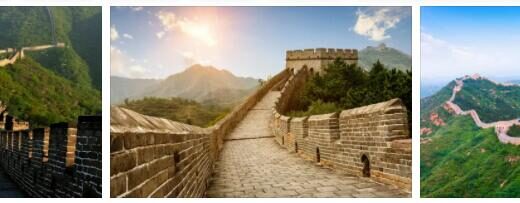Wulingyuan Landscape Park (World Heritage)
The impressive landscape in the north-west of Hunan Province has more than 3000 sandstone pillars. Sometimes more than 200 m high and were created by erosion over the course of millions of years. Rivers, lakes and 40 stalactite caves as well as two spectacular natural bridges make the park a unique experience.
Wulingyuan Landscape Park: Facts
| Official title: | Wulingyuan Landscape Park |
| Natural monument: | impressive landscape of 264 km² with over 3000 »sandstone pillars«, some of which tower more than 200 m high; 40 stalactite caves along the Suoxiyu River, including the 11 km longest cave in China with a 50 m high waterfall, and two natural bridges: 100 m above a canyon Xianrenqias (“Bridge of Immortals”) – 26 m long, 1.5-1, 8 meters wide and 1-2 meters thick – and Tianqiashengkong (“bridge across the sky”) – 40 m long, 10 m wide, 15 m thick and 357 m height, the highest in the world probably natural bridge |
| Continent: | Asia |
| Country: | China, Hunan |
| Location: | Part of the Wuling Shan, northwest of Changde and Changsha |
| Appointment: | 1992 |
| Meaning: | a unique geomorphological formation due to the massive quartz sandstone pillars |
| Flora and fauna: | over 3000 plant species, under 700 m plant species such as various maple species and the oak species Quercus glaucus, but also Phoebe zhenan, 700-950 m species such as Lithocarpus harlandii and Chinese head yew, over 950 m species such as Quercus spinosa and Rosa henryi, over 1000 m occurrence of Pinus massoniana; 34 mammal species such as red dog, collar bear, water deer and clouded leopard; 12 amphibian species such as the salamander species Andrias davidianus as well as 17 reptile and 53 bird species |
Mountain solitude in the heart of China
In the middle of the heart of China, wedged between the large metropolitan areas of Sichuan and the central reaches of the Yangze, lies a mountain range that has been forgotten by civilization and that has been able to preserve its unique natural beauties and diverse flora and fauna to this day. In addition to a spectacular natural landscape, almost untouched by human hands, with remnants of the primeval forest, which has now become rare in China, in the valleys of Wulingyuan – home to the minorities of the Miao, Bai and Tujia to this day – picturesque farming villages, surrounded by bright emerald-green rice terraces.
The members of these tribes have their own languages, customs and traditions and some of them still wear their traditional costumes made of indigo-colored fabrics, which they richly decorate with brightly colored embroidery and silver ornaments. The everyday life of the people here seems to be the same as it was hundreds of years ago. They build their houses out of wood according to the old tradition and cover them with clay bricks. The rice fields are tilled by hand with the help of the water buffalo. Scientists suspect that the Miao, Bai and Tujia do not originally come from this area, but from northern and eastern China. When wars and famines in the north caused a “wave of emigration” about ten centuries ago, they were driven here and gradually displaced into the lonely mountain regions by the overwhelming Chinese. The languages of these ethnic groups all belong to the Sino-Tibetan family. They do not have their own scripts, which is why most of them communicate in Chinese characters today.
In 1988, the Chinese central government declared the area around the village of Zhangjiajie, located on the northeastern edge of the Wuling massif, a historical and landscape park, in which the nature and traditional village structures of the local population are to be preserved. In this park, the visitor finds an “exciting” mountain world with bizarre rock towers, deep gorges, karst caves and rushing white water. The lush green mixed forests of the mountains have an extraordinary variety of subtropical vegetation. Among other things, this is the home of the Chinese tulip tree and the ginkgo, one of the oldest tree species on earth, which greened the world even during the lifetime of the dinosaurs. According to pharmacylib, a rare way Without the protection of the Chinese authorities, who would have threatened a similar fate as the ancient giant lizards are the snub noses of the golden monkeys. It is estimated that only a few hundred specimens of these elegant animals with gold-colored undersides and golden-yellow, silky hair, which the locals call “cowtail monkeys” because of their long tails, live in the heights of the local mountains.
According to historical records, the mountains of Wulingyuan were once an important pilgrimage center of Buddhism. Historians found an old stele with an inscription that says that “as many devout Buddhists once made a pilgrimage to the temples with their incense sticks as through the gates of a great city.” These shrines in the lonely mountains, where Buddhist monks sought the way to salvation through spiritual immersion, have been looted and destroyed several times over the past five centuries, the last time in 1949 during the fighting between communists and the troops of then President Chiang Kai- shek. Only ruins remained of the temples and the monks never returned. Instead of the pious pilgrims, it is now the tourists who visit the nature park, which has been increasingly marketed as a tourist attraction for several years. In 1994 an airport was inaugurated, which now enables visitors from the large metropolises of Beijing, Shanghai and Canton to fly into the remote mountain region within a few hours. It is to be hoped that the region will be able to withstand the onslaught of “civilization”.



